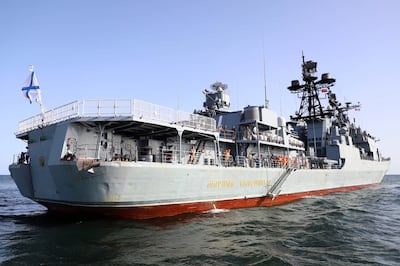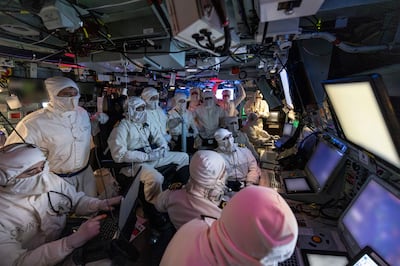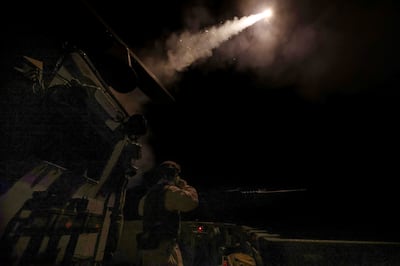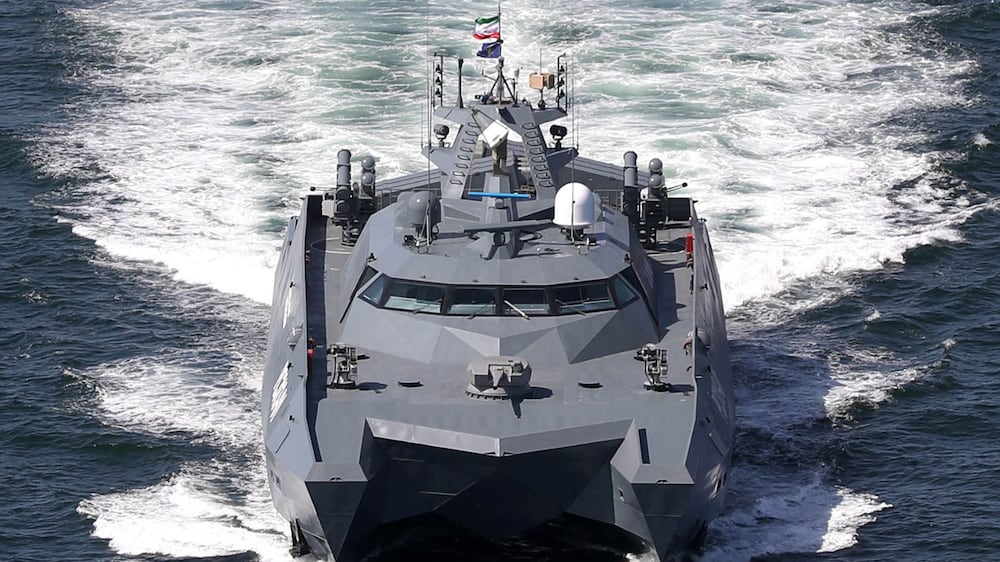A gathering of warships from China, Russia and Iran to carry out naval drills in the Gulf of Oman and Arabian Sea is “power projection in action”, military experts said.
The announcement of a major exercise involving 20 vessels from the three navies was made by state media on Tuesday and comes after American and British forces conducted further air strikes on the Houthi rebels in Yemen.
The exercise, called Maritime Security Belt 2024, will involve live firing at surface and aerial targets, potentially raising the risk of miscalculation or accident.
Dr Neil Melvin, director of international security studies at the Rusi think tank in London, said the exercise was part of a “long-term pattern where these three countries have been working much more closely together”.
“It’s not an alliance exactly but there is there is an increasing level of coordination that we see,” he told The National. “It’s also a signal to the West that they are not the only powers in town in an area which is strategically significant.”
The drills, the second held between the three countries in two years, would “consolidate security and its foundations in the region and expand multilateral co-operation among the participating countries”, Iranian state media reported.

Military analyst Tim Ripley argued that it demonstrated the navies had reach as “to get so many ships so far from their home ports is power projection in action”.
“This demonstrates that the British and Americans are clearly not the only game in town in the Red Sea region,” he added. “Others have interests and they have a duty to take notice.”
China will be sending the “guided missile destroyer Urumqi, guided missile frigate Linyi and comprehensive supply ship Dongpinghu”.
The Urumqi was previously sent to the region in 2021 in the Gulf of Aden, alongside the guided missile frigate Yantai. Launched in 2015, the vessel is one of China’s Type 052D missile destroyers, capable of carrying a variety of missiles in 64 launching cells, including anti-aircraft and anti-ship missiles.
For the exercise’s live ammunition aspect, it is highly like that the fleet will declare a “temporary firing zone” in international waters warning shipping to keep away.

However, Mr Ripley warned that if this involved anti-ship or surface-to-air missiles the “template gets bigger and more dangerous”, particularly for accidents or miscalculation.
Russia’s Defence Ministry said the “practical part of the exercise will take place in the waters of the Gulf of Oman in the Arabian Sea”, without specifying other locations.
The Russian component of the exercise came from its Pacific Fleet, led by the Varyag cruiser, docking in Chah Bahar in Iran earlier this week before the exercise began.
Last year, the three countries held a similar drill in the area, called Security Bond 2023.
There is also a suggestion that the exercise might have a secondary role in protecting the apparent Iranian spy ship the Behshad, that has allegedly been gathering information on vessels transiting the waterway to pass on to the Houthis.

The Behshad, which looks like a normal bulk carrier, has been in the Gulf of Aden since January conducting a meandering course close to the Bab Al Mandeb entrance to the Red Sea.
When it was in port for a while in February there was a noticeable drop in the Iran-backed Houthi shipping attacks.
“If this ship isn’t providing the Houthi regime with intelligence on vessel movements, then just what is she doing?” a naval source said.
Another defence source said: “There has been some loose talk about taking out Iranian ships helping the Houthis, so this exercise might also be sending a ‘hands off the Behshad message’.”
Growing naval might
China has the largest navy in the world, if measured in the number of surface ships, growing rapidly towards 400 ships by 2025, according to US estimates, although the US navy is twice the size in terms of tonnage of ships at sea.
Russia is a close second with about 360 ships, although its numbers are fluctuating as Moscow rushes to build replacements for, or repair about 25 ships lost or damaged in the Black Sea in the Ukraine war.
Iran is a relative newcomer to naval power projection, having traditionally built a large fleet of hundreds of missile attack boats intended to “swarm” and overwhelm enemy ships in the waters around the Arabian Sea.
But in recent years it has been able to send naval expeditions much further afield, sending the Sahand warship intelligence-gathering vessel Makran to Venezuela in 2021.
Earlier this month, China also sent vessels from the 46th fleet of the Chinese People's Liberation Army Navy in the Red Sea, but the ships have not been directly involved in shooting down Houthi drones and missiles. Analysts say the Chinese vessels have escorted some Chinese commercial ships through the Red Sea.
Missile interceptions have been undertaken by two coalitions, the US and UK-led Operation Prosperity Guardian, which includes Bahrain, Canada and Australia, and the EU-led Operation Aspides, which includes vessels from Germany, France, Italy and Belgium.
Unlike the US-UK led mission, Aspides has not directly attacked Houthi missile positions.
India has also sent vessels to the crisis zone, rescuing sailors after their vessels were struck by drones and missiles.






